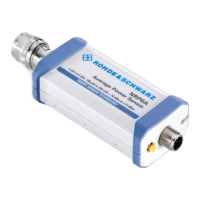Remote Control - Commands R&S NRP
1144.1400.12 6.90 E-3
Service Request, Use of the Hierarchical Structure
Under certain conditions, the device may send a service request (SRQ) to the controller. This service
request usually causes an interrupt at the controller to which the controller program can respond by
suitable actions. As shown in Fig. 6-11, an SRQ will always be triggered if one or several of the bits 2,
3, 4, 5 or 7 have been set in the Status Byte Register and enabled in the SRE. Each of these bits
combines the information from another register, from the error queue or the output buffer. If the ENABle
registers of the status registers are set accordingly, any bit in any status register will be able to trigger
an SRQ. To utilize the possibilities of the service request, all bits in the enable registers SRE and ESE
should be set to "1".
Examples (see also Fig. 6-11):
Use the *OPC command to generate an SRQ:
¾ Set bit 0 (operation complete) in the ESE.
¾ Set bit 5 (ESB) in the SRE.
¾ The device generates an SRQ upon completion of its settings.
Informing the controller by an SRQ that a measurement has been completed:
¾ Set bit 7 (summary bit of Status Operation Register) in the SRE.
¾ Set bit 4 (measuring) in the ENABle register of the Status Operation Register.
¾ Set bit 4 in the NTRansition register of the Status Operation Register to ensure that the transition
of measuring bit 4 from 1 to 0 (end of measurement) is also recorded in the EVENt register.
¾ The device generates an SRQ when the measurement is completed.
The SRQ is the only way for the device to become active of its own. Each controller program should set
the device such that a service request is triggered in case of malfunctions. The program should respond
accordingly to the service request.
Serial Poll
Like the *STB? command, the serial poll is used to query the status byte of a device. Querying is
implemented by interface messages, however, and is therefore much quicker. The serial poll method
has already been defined in the IEEE 488.1 standard, and used to be the only standard method of
querying the Status Byte Register. This method also works with devices that conform neither to SCPI
nor to IEEE 488.2. Serial poll is mainly used to obtain a quick overview of the device status of several
devices connected to the IEC/IEEE bus.

